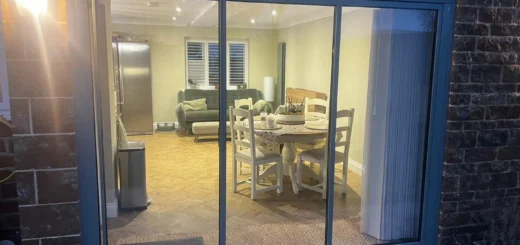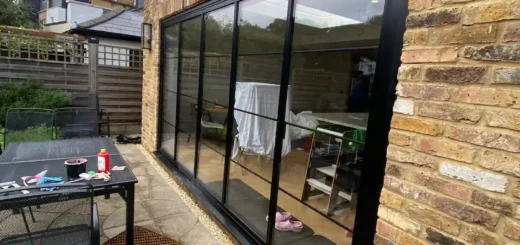Sliding Balcony Doors: Design & Style Guide
Table of Contents
Types of Sliding Balcony Doors
Modern sliding balcony doors come in several distinct configurations, each designed for specific uses and spaces. From compact systems perfect for city flats to expansive designs for penthouse terraces, the right choice depends on your space and requirements.
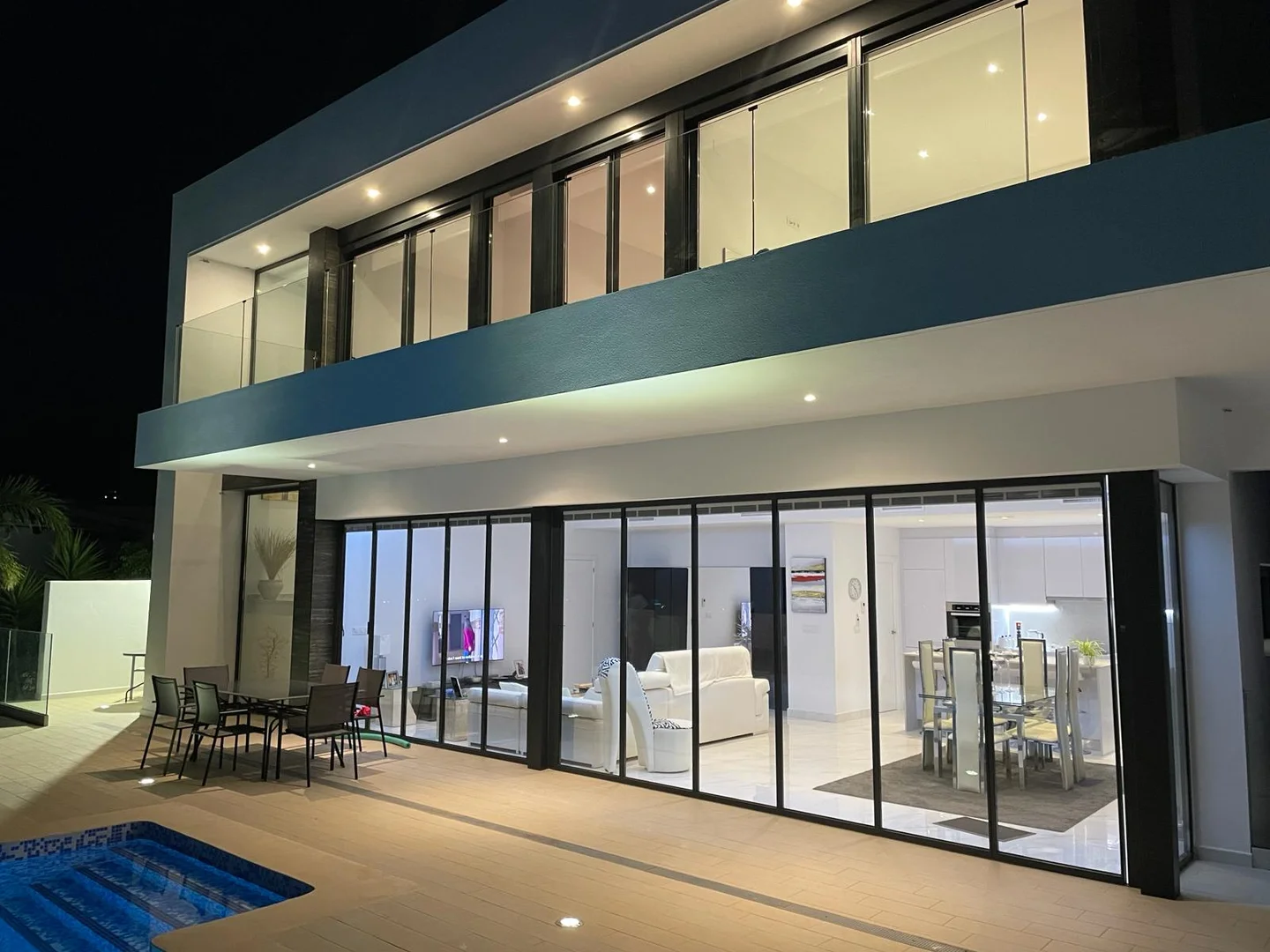
Inline Sliding Systems
Inline systems rank among the most popular choices for sliding balcony doors in British homes. Running parallel to fixed panels on tracks embedded in the floor, these doors slide smoothly past one another without taking up extra space. The hardware consists of rollers mounted either at the top or bottom of each panel, with most premium systems using both for superior stability.
Unlike conventional sliding patio doors, balcony variants need extra weatherproofing due to their exposed position. Multi-point locking mechanisms keep the panels firmly sealed against wind and rain, while brush seals between the panels stop draughts without impeding movement.
Lift and Slide Mechanisms
Pushing down on the handle of a lift-and-slide door raises the entire panel off its track, this makes even large glass panels feel surprisingly light. The panels glide effortlessly on specially designed rollers, then lower back onto the track when closed to form an airtight seal.
Glass balcony doors in lift-and-slide configurations often incorporate triple-glazed panels for superior insulation. The robust frame construction supports wider panels than standard sliding systems, letting you frame broader views of the cityscape or countryside beyond your balcony.
Tilt and Slide Options
High-rise flats benefit particularly from tilt-and-slide systems, which combine two distinct opening modes in one door. The tilt function tips the top of the panel inward for ventilation while keeping the bottom secured—perfect for catching a breeze without compromising safety. When fully opened, the panels slide smoothly to one side just like a standard sliding door.
Security features built into contemporary design elements make these systems especially suitable for elevated balconies. Multipoint locking engages automatically when the door tilts, while reinforced frames and laminated glass add extra protection against weather and unwanted entry.
Advanced Operating Systems
Modern balcony sliding doors often incorporate sophisticated hardware that makes operation practically effortless. Soft-close mechanisms prevent slamming, while advanced thermal breaks in the frames stop condensation forming in cold weather. Premium systems might include motorised operation, letting you control ventilation with a remote or smart device—particularly useful for less accessible panels in larger installations.
Design Guide for Sliding Balcony Doors
Choosing the right configuration for balcony sliding glass doors involves careful planning around views, proportions, and available space. Your choice of frame materials, glass types, and opening styles shapes not just the look of your balcony entrance but how you’ll use your outdoor space year-round.
Glass Panel Sizes and Configurations
Large glass panels create striking views, yet size limits vary by system and material. Top-hung aluminium sliding doors support wider panels than standard bottom-rolling designs, with some systems allowing glass sections up to three metres wide. Larger panels mean fewer frame interruptions—but they also weigh more and cost more to replace.
Panel arrangement deserves careful thought in tight spaces. A single sliding panel with one fixed section provides good access while keeping hardware minimal. For wider openings, multiple panels can stack to one or sides, though this requires more track space. Corner-opening configurations remove the corner post entirely, opening up spectacular diagonal views.
Modern balcony design often favours minimalist frames that put the focus on the view. Yet ultra-slim frames aren’t always the best choice—wider profiles can support triple glazing for better insulation and noise reduction. The key lies in finding the right balance between frame size and glass area for your specific situation.
Frame Materials and Finishes
Aluminium sliding balcony doors resist corrosion exceptionally well, making them ideal for exposed locations. Their strength allows for slimmer frames than other materials, while thermal breaks prevent heat loss through the metal. Powder-coated finishes come in hundreds of colours and resist fading from sun exposure.
Wood frames bring natural warmth but need more upkeep in exposed positions. Engineered timber combines the beauty of natural wood with improved stability, though it costs more than standard timber. Composite frames sandwich a timber core inside aluminium cladding, offering the best attributes of materials.
Double glazed aluminium sliding doors are standard on most installations, but triple glazing might prove worthwhile for noise reduction in urban areas. Low-iron glass removes the slight green tint seen in standard glass, showing true colours through your windows. Solar control coatings reduce heat gain without darkening the glass noticeably.
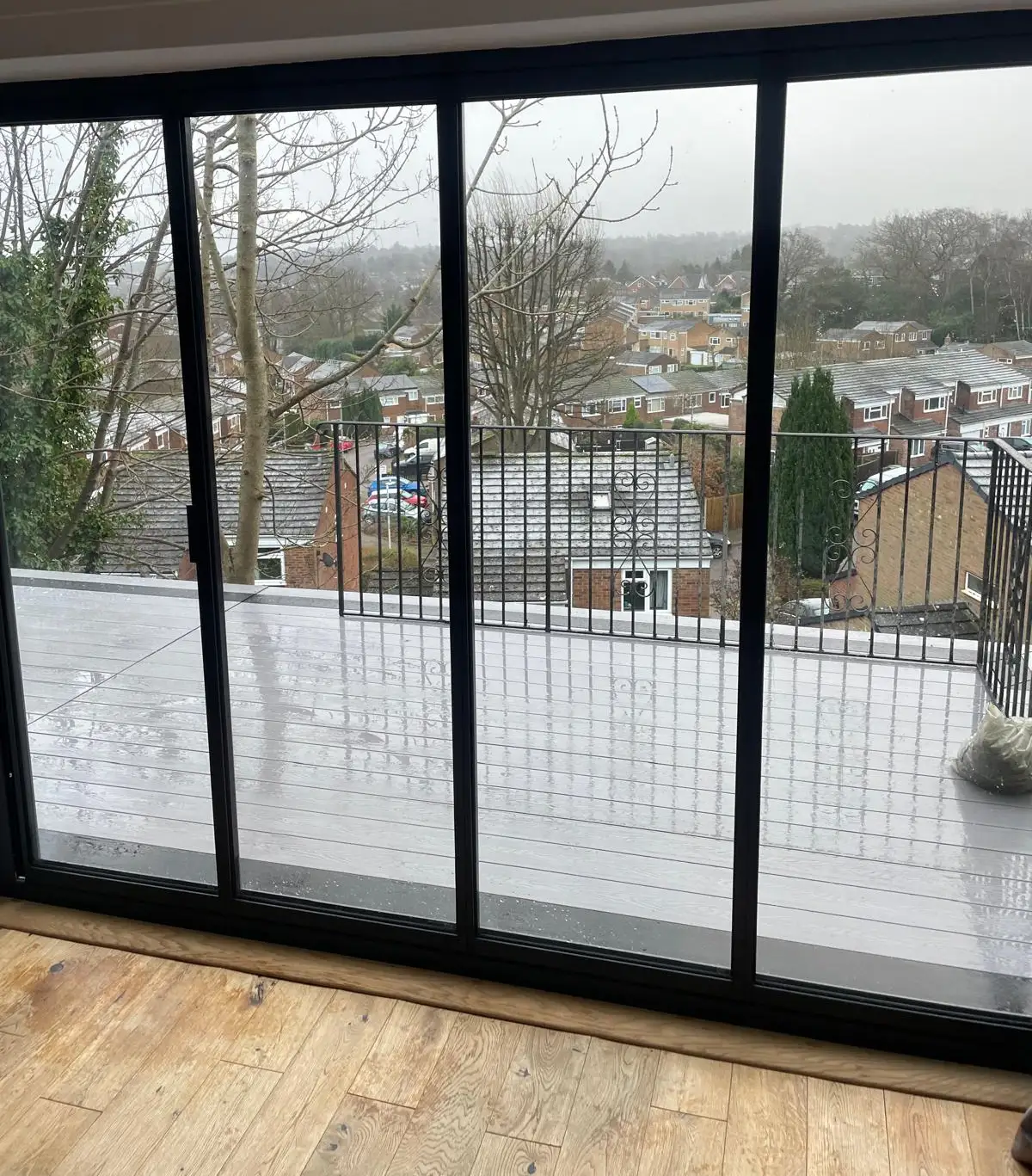
Sightlines and Views
Frame placement radically changes how sliding balcony doors frame your view. Slim mullions between panels create minimal interruption, while chunky frames can frame views like pictures. Strategic placement of fixed and moving panels lets you maintain clear views through the most important angles.
Small balconies benefit from careful glass selection. Anti-reflective coatings reduce mirror effects that make spaces feel smaller, especially at night.
Self-cleaning glass, while pricier, keeps views clear with minimal maintenance—particularly valuable on high-rise balconies where cleaning access proves difficult.
Advanced Glazing Options
Low-maintenance glass technologies continue advancing. Electrochromic glass changes from clear to opaque at the touch of a button, providing privacy without curtains or blinds. Laminated acoustic glass reduces noise substantially compared to standard double glazing, using a special interlayer to absorb sound waves. These options cost more initially but can eliminate the need for additional window treatments.
Technical Specifications
Glass sliding balcony doors must meet strict safety standards, particularly in high-rise installations. Toughened glass, required by building regulations for doors, breaks into small rounded pieces rather than sharp shards. Laminated glass adds further security, holding together even if broken.
Panel weight influences hardware choice profoundly. Premium rolling systems carry heavier glass with less effort, while lift-and-slide mechanisms make even large panels feel light. Running gear quality becomes especially important with frequent use—better bearings last longer and operate more smoothly.
Drainage details need particular attention for balcony installations. Tracks include water evacuation channels to prevent pooling during rain. Threshold options range from completely flat for easy access to raised profiles offering better weather protection. Many systems now offer low thresholds that combine good weather resistance with easy passage.
Styling Your Sliding Balcony Doors
Sliding balcony doors serve as the centrepiece of your outdoor space, shaping how you experience and use your balcony. The right design choices in frames, glass, and surrounding elements can turn an ordinary balcony into a stunning architectural feature.
Period Property Integration
Victorian and Georgian properties demand careful attention when installing sliding balcony doors. Slim profile sliding glass doors work particularly well in period settings—their minimal frames don’t compete with ornate architectural details. Choosing frame colours that match existing window frames maintains visual harmony, while black frames can echo traditional steel windows.
Original sash windows often inspire the proportions of new balcony glazing. Horizontal glazing bars in sliding balcony doors can mirror the dimensions of existing windows, creating visual consistency across the façade. Some manufacturers offer stick-on glazing bars that replicate traditional patterns while maintaining the benefits of modern glass units.
For properties with cast iron balconies, powder-coated frames in dark greys or bronze tones complement the metalwork beautifully. Custom sizes allow exact matching of original apertures, respecting the building’s heritage while improving its thermal performance. Some homeowners opt for antiqued brass or bronze hardware to match period door furniture.
Contemporary Minimalist Designs
Modern architecture calls for clean lines and expansive glass. Floor-to-ceiling glass sliding balcony doors create striking walls of light, with frames hidden in the ceiling and floor. Flush thresholds eliminate any step between inside and out, while corner systems remove visible supports entirely.
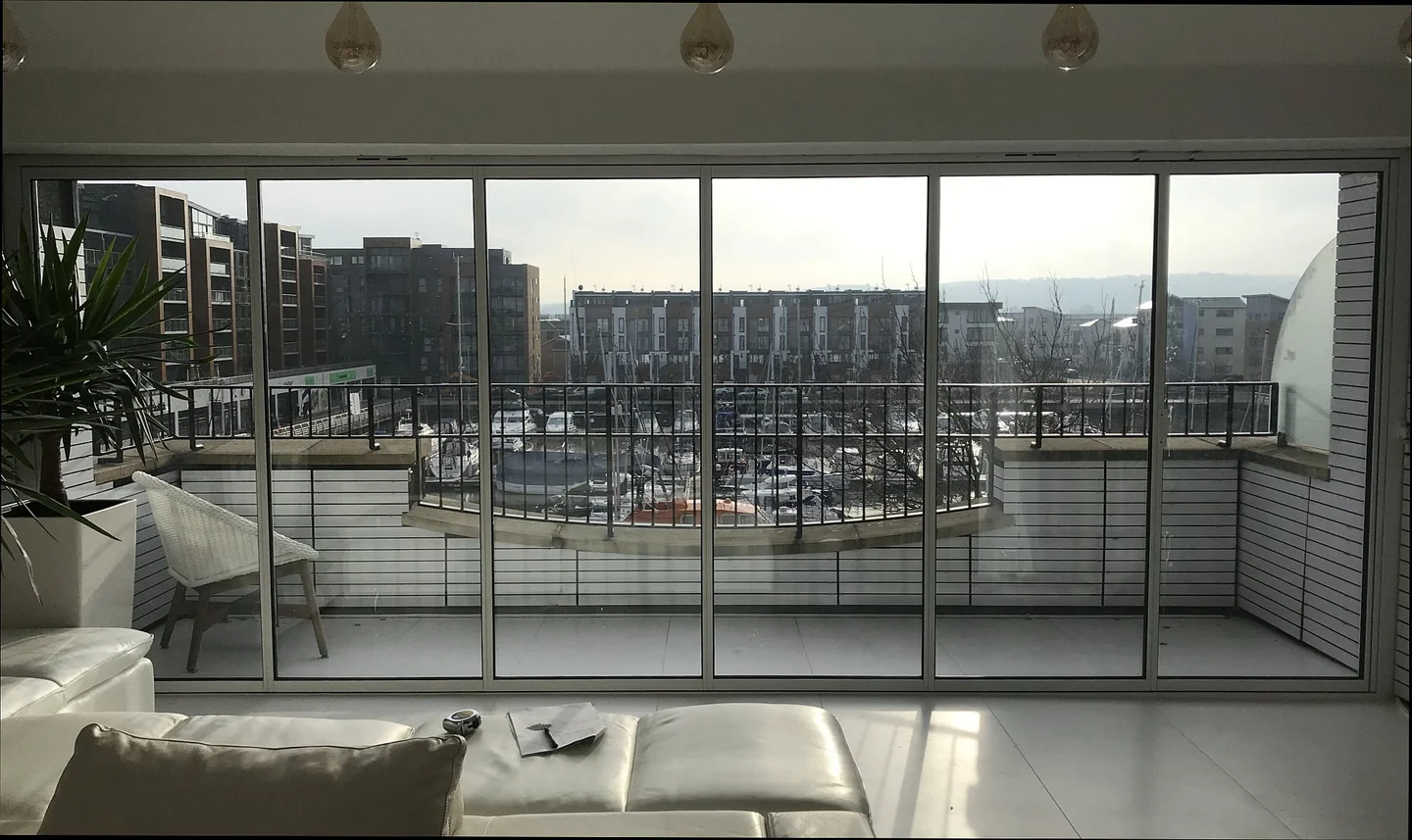
Exterior colours play a big part in contemporary design schemes. Dark anthracite frames disappear against the glass, emphasising views rather than frames. Alternatively, bold colours on frame exteriors can create dramatic contrasts—deep blues and greens work particularly well against pale stone or render.
Shadow gaps around door frames add sophisticated detailing to minimalist installations. Recessed tracks eliminate visible floor guides, while concealed fixings keep lines clean and uncluttered. Handle designs have evolved too, with minimal flush pulls replacing traditional lever handles.
Industrial Style Applications
Raw materials and strong geometries define industrial-inspired sliding balcony doors. Steel-look aluminium frames offer industrial aesthetics with modern thermal performance. Grid patterns in the glass reference factory windows, while maintaining clear views through each pane.
Dark frame finishes—from graphite to pure black—dominate industrial schemes. These strong tones contrast beautifully with exposed brick or concrete, creating architectural impact. Some systems offer textured powder coatings that replicate the feel of raw metal.
Advanced Frame Treatments
Special finishes can add unique character to sliding balcony doors. Anodised aluminium provides subtle metallic sheens that change with the light, while textured powder coatings offer tactile interest. Some manufacturers now offer dual-colour options—different finishes inside and out—letting you coordinate with various schemes.
Material Combinations
Natural materials near sliding balcony doors soften their appearance. Timber decking or stone flooring can run right up to door frames, reducing visual barriers. Wall claddings in wood or stone adjacent to glass create striking material contrasts without overwhelming the space.
Glass types influence the overall aesthetic substantially. Grey-tinted glass reduces glare while adding sophistication to contemporary designs. Reflective coatings can mirror surrounding materials during the day while remaining transparent from inside.
Lighting requires particular attention around glass doors. Hidden LED strips in door frames or surrounding architecture create subtle evening ambiance. Well-placed outdoor lighting prevents glass from becoming a black mirror at night, keeping the connection between spaces alive after dark.
Using Sliding Balcony Doors in Small Spaces
Limited balcony space demands creative approaches to door design and layout. Sliding balcony doors can actually make compact areas feel larger through careful panel arrangements and smart use of glass.
Space-Saving Configurations
Pocket doors slide completely out of sight into wall cavities, freeing up valuable balcony space. While this requires specific wall construction, the results can be spectacular—especially in small city flats where every centimetre counts. Custom made sliding doors fit precisely into these pockets, with specialised hardware ensuring smooth operation even after years of use.
Standard sliding balcony doors typically need space for panels to stack beside the opening. Corner-opening systems eliminate this requirement by allowing panels to meet at 90-degree angles without a fixed post. When open, these doors create a striking diagonal view that makes the balcony feel like a natural extension of the room.
Outdoor living becomes more practical with the right door layout. Multi-track systems let you partially open specific panels for ventilation while keeping others closed—perfect for enjoying fresh air without giving up precious floor space. Some systems even incorporate sliding fly screens that disappear when not needed.
Light and Space Techniques
Glass selection profoundly shapes how spacious a balcony feels. Low-iron glass removes the slight green tint seen in standard patio doors, creating crystal-clear views that trick the eye into seeing more space. Anti-reflective coatings reduce mirror effects that can make spaces feel enclosed, particularly at night.
Slim frames in custom colours can virtually disappear against their surroundings. Dark frames against dark walls create an illusion of floating glass, while matching frames to interior colours helps them recede visually. Frame placement near walls or corners can make the glass appear to extend beyond its actual boundaries.
Visual Tricks for Small Spaces
Optical illusions can make compact balconies feel surprisingly roomy:
- Vertical frame divisions draw the eye upward
- Horizontal lines lead the gaze outward
- Minimal frame intersections reduce visual clutter
- Full-height glass emphasises ceiling height
- Clear glass balustrades extend sight lines
Flexible Living Options
Glass sliding balcony doors help small balconies serve multiple purposes throughout the year. Wide openings turn tight spaces into dining areas in summer, while excellent insulation keeps these spaces usable well into autumn. Careful planning of furniture layouts ensures doors can open fully without obstruction.
Panel sizes need careful calculation in restricted spaces. Smaller panels might open more easily in tight spots, but larger ones provide better views when closed. The ideal balance depends on how you plan to use the space—some homeowners prefer fewer, larger panels for clearer views, while others value the flexibility of multiple smaller sections.
Seating arrangements around sliding doors require particular thought. Built-in benches can double as storage while providing comfortable spots to enjoy the view. Folding furniture allows quick rearrangement when you need to open the doors fully, while stackable chairs tuck away neatly when not in use.
Multi-Purpose Design
Modern apartments often combine living areas with balconies to create larger-feeling spaces. Sliding glass balcony doors make this integration feel natural, especially when floor finishes run continuously from inside to out. Matching interior and exterior materials reinforces this connection without compromising the distinctness of each space.
Lighting plays a vital part in making small balconies useful after dark. Subtle LED strips around door frames provide ambient light without harsh glare on the glass. Well-placed outdoor lamps prevent the glass from becoming a black mirror at night, maintaining the feeling of extra space even after sunset.
Storage solutions integrated with door systems help keep small balconies uncluttered. Recessed tracks eliminate trip hazards while providing space for concealed drainage. Some manufacturers offer integrated blinds within the glazing units—a neat solution that doesn’t take up any extra space.
Practical Tips for Sliding Balcony Doors
Living with sliding balcony doors brings unique requirements, from safety in high-rise settings to ensuring year-round comfort. Smart choices in hardware, glass, and safety features help you get the most from your balcony space.
Safety Features for High-Rise Use
Tall sliding doors especially need robust safety measures, particularly in apartments above ground level. Advanced locking mechanisms prevent unauthorised opening, while toughened safety glass withstands impacts. High-level installations often incorporate additional security features like multi-point locking and anti-lift devices.
Glass specifications matter enormously in elevated positions. Laminated safety glass holds together even if broken, while toughened glass breaks into small, rounded pieces rather than dangerous shards. Many sliding balcony doors now use a combination of these technologies, with laminated glass on the inside and toughened glass on the exterior.
Living at height brings specific operating requirements. Pressure differences between inside and outside can make large doors harder to slide, but premium hardware compensates for this effect. Restrictor hinges limit how far doors open in windy conditions, while still allowing adequate ventilation.
Weather Performance
British weather demands excellent water resistance from glass sliding balcony doors. Drainage channels built into the tracks direct water away from living spaces, while brush seals between panels keep out draughts. Modern systems include pressure-equalisation chambers that prevent water ingress even in driving rain.
Low threshold sliding doors improve accessibility while maintaining weather protection. Special track designs incorporate drainage without creating a step, ideal for seamless movement between spaces. Energy efficient doors with thermal breaks in their frames prevent condensation forming in cold weather.
Wind resistance becomes particularly important for exposed balconies. Robust frame construction and thick glass resist wind pressure, while special seals prevent whistling in strong gusts. Patio doors designed for high-rise use often exceed standard weather ratings to cope with increased exposure.
Advanced Weather Protection
New technologies improve comfort in extreme weather:
Thermal breaks in frames cut heat loss substantially. Multi-chamber profiles increase insulation without adding bulk. Warm-edge spacer bars between glass panes reduce condensation risk. Some systems incorporate automatic seals that engage fully when the door closes.
Privacy
Privacy needs vary throughout the day and year. Solar control glass reduces glare while maintaining clear views out. Switchable glass changes from clear to opaque at the touch of a button—particularly useful for overlooked balconies.
Internal blinds sealed within the glazing unit offer convenient privacy control without collecting dust. These systems suit high-rise applications particularly well since they never need cleaning and won’t rattle in the wind. External screens can provide shade without blocking views entirely.
Careful glass selection helps balance privacy and views. Reflective coatings create one-way privacy during daylight hours, while still allowing clear views after dark. Some coatings combine solar control with privacy benefits, reducing cooling needs in summer.
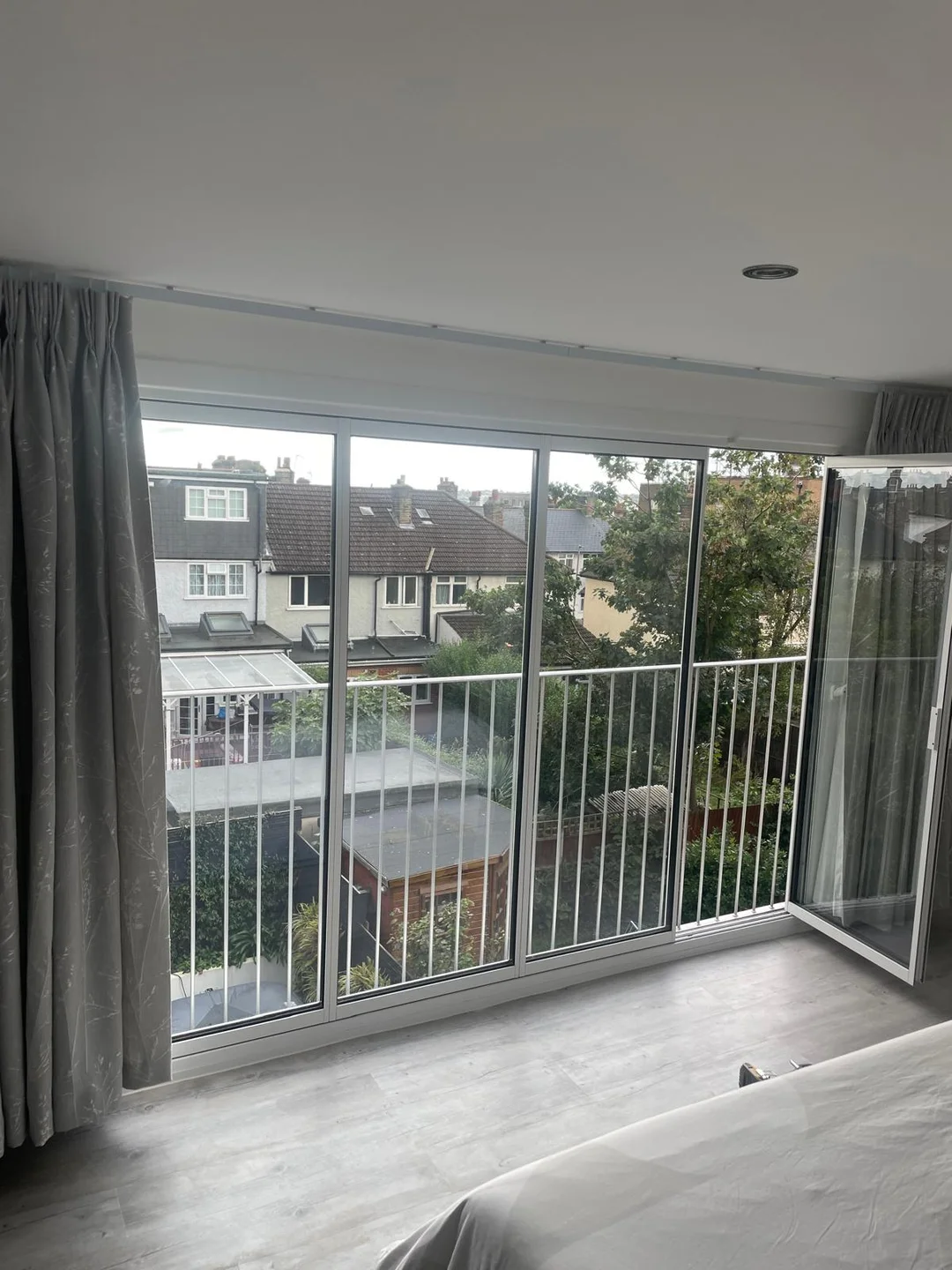
Multi-Season Usage
Sliding balcony doors need different features for different seasons. Summer ventilation relies on smooth-running hardware and good fly screening. Winter comfort depends on excellent seals and insulation. The best systems work well year-round without requiring seasonal adjustments.
Frame choice strongly influences thermal performance. Aluminium frames with thermal breaks prevent heat loss through the metal, while multiple weather seals block draughts effectively. Triple glazing might prove worthwhile in exposed locations, though double glazing suffices for most British installations.
Operating mechanisms should work smoothly in all weather conditions. Quality hardware resists corrosion from salt air in coastal locations. Stainless steel components last longer than standard fittings, particularly in exposed positions.
Accessibility and Ease of Use
Door weight hugely impacts usability. Premium hardware makes even large panels slide easily, while soft-close mechanisms prevent slamming. Handle height and style need careful thought—lever handles prove easier to grip than recessed pulls for many users.
Flush thresholds eliminate trip hazards but need regular cleaning to run smoothly. Some systems include self-cleaning tracks that flush debris away automatically when it rains.
Regular maintenance keeps sliding balcony doors working properly. Cleaning tracks prevents debris build-up that could impede operation. Lubricating rollers and locks annually helps ensure smooth movement year after year.
About SunSeeker Doors
With over 20 years of experience, SunSeeker Doors remains at the forefront of door design with our quality-tested patio doors and related products, including the bespoke UltraSlim aluminium slide and pivot door system, Frameless Glass Doors, and Slimline Sliding Glass Doors. All of our doors are suitable for both internal and external use.
To request a free quotation, please use our online form. You may also contact 01582 492730, or email info@sunseekerdoors.co.uk if you have any questions.


